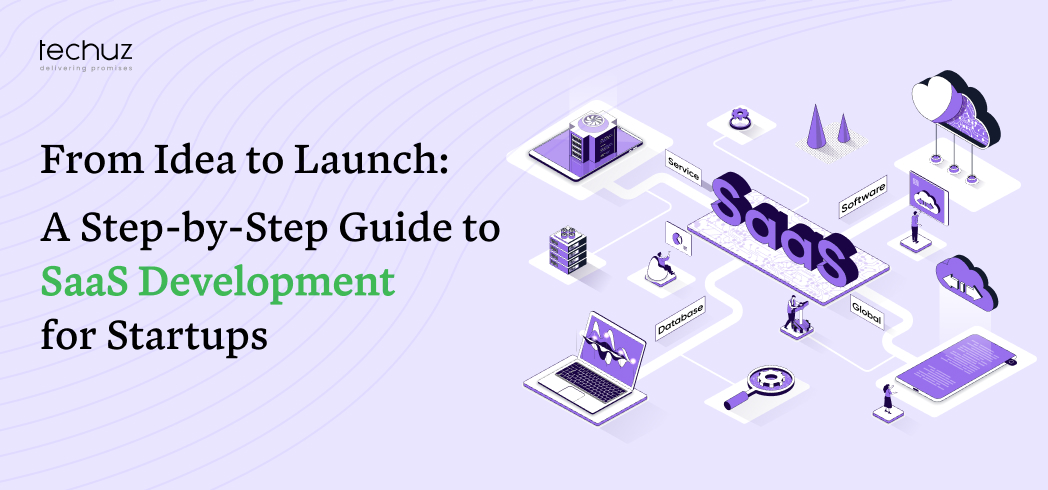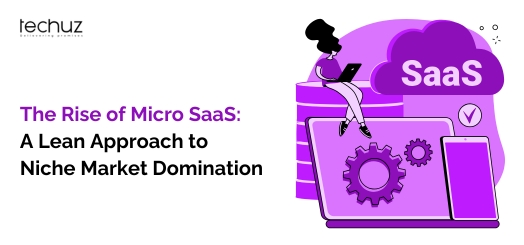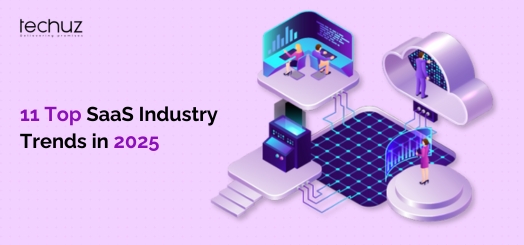Posted on
October 29, 2024
Read time
 12 mins read
12 mins read
Quick Summary – This book brings together the entire SaaS development process-from idea validation to scaling for growth: market research, product strategy, tech stack, UI/UX design, development methodologies, security, and launch strategies-through long-term maintenance practices and applies practical, action-oriented steps to build a scalable, secure, and user-friendly SaaS product. Using this roadmap, startups will better be able to understand the complexity of the SaaS development process and better prepare themselves for sustainable growth and success.
Table of Content
Introduction to SaaS Development
We really gotta begin from the Scratch………This is a software distribution model where applications are hosted through the cloud and accessed over the internet. This paradigm has completely changed how businesses, particularly startups, create value for customers by providing flexible, scalable, and infrastructurally light software solutions. Conventional software, which requires installation and periodic updates by a human, is different from SaaS applications that can be accessed from any device with access to the internet and will automatically update without human intervention.
Why SaaS is Popular for Startups
Now let’s talk about the real business ……Startups prefer the SaaS model nowadays mainly because it is scalable, can reduce the initial costs of a venture and offer high availability and reliability in terms of software delivery. Thus, SaaS allows startups to enter markets fast without setting up costly infrastructures. Among its most convincing points are these:
Scalability: SaaS applications can handle growth with less effort. Cloud services scale automatically and take up more users at just the right time when demand by users rises.
Cost Efficiency: Since the SaaS applications run on cloud infrastructure, startup companies need not invest in expensive servers and hardware. The cost of maintenance is also reduced by this.
Automatic Updates: SaaS products enable companies to push updates for all users at once, thus improving the user experience while minimizing the downtime period.
With these benefits in mind, SaaS has emerged as the most popular business model among startups looking to establish a very quick market presence.
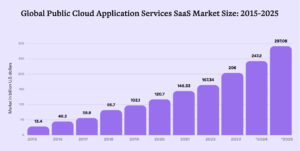
Phases of SaaS development
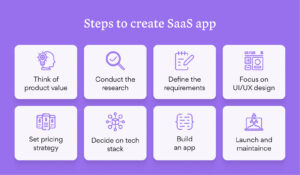
Phase 1: Idea and Market Research
Validation of the Idea for SaaS Product
It is critical to validate the SaaS idea before beginning to develop. This way, time and money won’t be wasted on a product that doesn’t have enough demand in the market. Idea validation combines actual need for a solution to a problem – both for your product and in return for money from customers. You can achieve this through the following means:
- Surveys and interviews with probable customers to understand their needs.
- Competitor Analysis to know how others have solved the problem or to identify opportunities in new market space.
- Online tools, such as Google Trends, and keyword research, to know if enough people care about your product and idea.
Market Research and Competitor Analysis
A good market research therefore means knowing your target audience and understanding how you stack up in a competitive landscape. Here is how to do it:-
- Identify your Target Audience: Define your customer personas, what you consider as demographics (age, location, job roles), and behaviors (pains, motivations). Tools like Google Analytics, and customer surveys help with this aspect.
- Analyze Competition: Assess your competition to know what they offer and how they position themselves. Use tools like Ahrefs or SEMrush to analyze their SEO and content strategy.
This research not only defines your product but also informs marketing and sales strategies so that you could distinguish yourself from the competition.
Customer feedback for validation of ideas
It’s most important to get early feedback from potential users. You can make up a prototype or even a landing page describing your SaaS product and its value proposition to that user group. By taking it to the people you target, you will be able to hear their feedback. Google Forms or Typeform can come in handy to collect your findings. This feedback loop helps hone your idea for a product so that you’re building something people need.
Phase 2: Product Strategy and Planning
Defining a Product Roadmap
A product roadmap is a strategic document explaining which features are built when. High-impact features that solve customer pain points should be given to the starters early. This will focus the entire development team on development priorities, so every development stage brings measurable value.
Minimum Viable Product Definition
The minimum viable product is the leanest version that solves the most vital problem for your users. This means a startup can get this to market quickly to start collecting user feedback before more features are built in. Having an MVP as the first product reduces the risk of building extra, unwanted features and helps validate market demand for a product. For example, Dropbox was born as an MVP with a feature that sounds as simple as file sharing; it was therefore sufficient to draw early users and validate the concept before further extension.
User Story Mapping for Feature Planning
User story mapping is yet another method by which you can visualize the core functions of your application and really start doing a prioritization of what you’re going to build. You can clearly visualize features that are going to deliver near-term value, ensuring an extremely smooth user experience as you think about the journey of your user through your application. Here come in handy Jira and Trello.
Phase 3: Choosing the Tech Stack
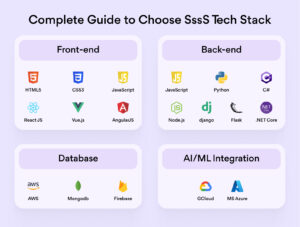
Backend Technologies for SaaS
Backend technologies to be used will depend on the requirement of scalability, security, and performance. Most startups therefore opt for frameworks that are both flexible and powerful: Node.js is excellent for handling a high number of concurrent connections, making it perfect fit for real-time applications. Ruby on Rails Known for its rapid development, Ruby on Rails is an excellent choice for any startup looking to rapidly prototype and launch their SaaS product.
Large ecosystems within these frameworks allow third-party services to be easily plugged in and greatly shorten development time. If you hire SaaS development company then they will evaluate the technology based on your vision, use case and industry best practices. So it can scale in future when saas product will have good number of daily users.
SaaS Front-end Technologies
Front end development by startups should be in frameworks that allow fast rendering with smooth interactivity and reusable components:
- React.js: Developed by Facebook, React has become the go-to choice because of its virtual DOM, improving on performance and scalability.
- Vue.js: Light in weight, similar to React, which is very aptly used for designing agile and high-performance user interfaces while avoiding steep learning curves.
Cloud Platforms and Tools for Scaling
Selecting the correct cloud platform is also essential to scale your SaaS product. Top selections are as follows:
- Amazon Web Services (AWS): AWS features a plethora of tools such as Elastic Compute Cloud (EC2), S3, and so on, for offering computations and storage needs.
- Microsoft Azure: Azure is highly known for its enterprise-grade security and smooth integration with other tools of Microsoft.
These technologies support auto-scaling, so that the infrastructure really adjusts to increased user demand
Phase 4: UI/UX Design
Significance of User-Centric Design
The interface of a SaaS application determines the stay rate of a customer. Seamless user experience translates into satisfied users who are more likely to hang around. Therefore, intuitive and user-friendly designs that reduce friction and make it possible for users to attain whatever they want should be the top priority.
User Journey Mapping
The user journey mapping will help identify the most important touchpoints and possible pain points a user may experience while using your SaaS application. With an understanding of the steps that help a user move toward using the feature, the interface will then clearly point in their direction, hence causing confusion while being improved over satisfaction and it will ease the UI/UX design journey
Prototyping and Wireframing
Ensuring one prototypes the design before starting full-scale development is a very critical step. Figma, Sketch, and InVision allow startups to develop clickable prototypes and run tests for user feedback, thus ensuring that design decisions are well-informed. It helps wireframes visualize the layout so stakeholders can iterate quickly and come up with the final design before handing it in.
Phase 5: Development and Testing
Agile and Scrum Methodologies
Other iterative methods which are also widely used in SaaS development include Agile Methodology and Scrum. These represent the essence of continuous iteration, testing, and refinement. The development process is broken up into shorter sprints within which the startups must ensure delivery of value. The introduction of continuous stand-up meetings besides sprint retrospectives helps bring teams on board as quickly as possible with these changing needs.
CI/CD Pipelines for Continuous Delivery
Continuous Integration and Continuous Deployment can be described as a repeatable process of building, testing, and deploying code. This makes it possible for startups to push easy new updates without affecting the user experience. Tools like Jenkins, GitLab CI, and Circle CI make it easier to set up a CI/CD pipeline that ensures code goes through thorough testing and is deployed uninterruptedly.
Testing SaaS Products
A significant aspect of the process is testing for a stable and reliable product. The following are the major types of testing required for SaaS:
- Unit Testing: Ascertains that the individual components of the software behave as expected.
- Integration Testing: Verifies that different modules interact without producing errors.
- Stress Testing: Simulates extreme load conditions by actual or emulated heavy users to identify performance bottlenecks and ensure the application remains responsive under higher demand.
Phase 6: Security and Compliance
Security for SaaS Startups
Because SaaS has to deal with all that sensitive data most of the times, security is a top-of-the-line concern when it comes to SaaS products. The following can be adopted in order to protect users and ensure that trust is not lost:
- Use Data Encryption: This ensures protection for data at rest as well as in motion. SSL/TLS certificates should be ensured; this is pivotal in securing communications.
- Implement Multi-Factor Authentication. This adds another layer of authentication when the reduction of risk of unauthorized access to accounts is concerned.
Compliance with GDPR and HIPAA
Depending on the kind of market you are targeting, your SaaS application ought to be compliant with the prevailing regulations in that particular market. Examples:
- GDPR or General Data Protection Regulation: This will apply to all the enterprise that processes any personal data of EU citizens.
- HIPAA or Health Insurance Portability and Accountability Act: This ensures the safety and privacy of health-related data in the US. To be compliant, one has to implement data privacy policies and security audits and acquire certifications among others.
Secure Cloud Services
The cloud is flexible but offers keen security practice. In this area, some of the best practices followed here include regular security audits, automated vulnerability patching, and continuous monitoring for suspicious activities.
Phase 7: Launch and Post-Launch Strategy
Launch Your SaaS Product
Plan, market, and time your launch for a successful SaaS launch. Key strategies are:
- Digital Marketing: Use SEO, paid ads, and content marketing for garnering traffic to your product.
- Beta Testing: Beta testing happens either on a private or public beta after which real-world feedback, including bugs, is gathered before the full launch.
Monitoring and Support After Launch
The moment your product goes live, you can begin to keep tabs in real-time with tools such as Google Analytics and AWS CloudWatch. Monitoring support after a launch means responding on time to inquiries from a user, fixing bugs, and ensuring that any downtime is sorted out right away.
Feedback
Post-launch, user feedback becomes invaluable for guiding updates to the product. Survey users frequently and dig into usage data to find where users really like features and where they create friction. Weave that feedback into subsequent updates to the product for continuous improvement.
Phase 8: Scaling and Growth
Scaling SaaS Applications
Scaling a SaaS product means improving performance, increasing feature sets, and using new features in auto-scaling and load balancing on the likes of AWS or Azure so that you can accommodate an increase in traffic without any downtime. But then again, your code base and database queries must be constantly optimized to maintain speed with increased user bases.
Managing Increasing User Demand
As you scale in customer acquisition, your infrastructure must support it. Tools like AWS Auto Scaling automatically scale resources while maintaining uptime so that Elastic Load Balancing distributes traffic efficiently.
Conclusion: Long-Term SaaS Maintenance
While development for SaaS isn’t really the case once a product is brought to market, the magic really does happen after some long period of time. Here, you need to be persistently making updates and continuously providing support to customers while being agile with changes in the marketplace. The following are thus what you should concentrate on towards long-term product health :
- Synchronize regular updates for fixing bugs, bringing on new features, and optimizing performance.
- Customer Support: Engage a responsive customer support that identifies issues quickly and holds on to your user.
- Keep track of market trends- Gather feedback from users and be dynamic to the changing market trends.
Hopefully, by following this guide, startups could overcome all the hurdles in SaaS development processes and be better prepared for long-term success in the fast-growing world of cloud software.
